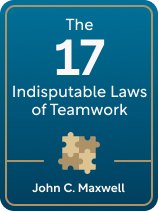

This article is an excerpt from the Shortform book guide to "The 17 Indisputable Laws of Teamwork" by John C. Maxwell. Shortform has the world's best summaries and analyses of books you should be reading.
Like this article? Sign up for a free trial here.
What are the best strategies for how to build a strong team? Can choosing team members wisely help you achieve your goals?
To build a strong team, you need to evaluate what roles you need to fill and make sure that each new member adds to the greater picture. By understanding what these roles are and what they require, you can learn to build a stronger team.
Discover how to assemble an effective team with these strategies.
How to Assemble a Winning Team
A winning team is a group of people who unite under a common identity and who trust and support one another to achieve shared goals. In this article, we’ll discuss how to build a strong team by selecting individuals with the right skills and attitudes, creating shared visions and values, and nurturing a culture of trust and positivity.
Assemble the Right Team for Your Goal
To build a team that can achieve great things, you need to have the right people on it. Select team members based on the type of goals and challenges you face. Getting clear on what you’re trying to accomplish and what obstacles you’ll likely face will help you identify people who have the right skills, attitudes, and values for your team.
For example, if you’re venturing into new or unknown territory (like founding a startup), you’d likely benefit from having a creative team. In contrast, if you’re facing a high-stakes challenge (like a sensitive negotiation), you may want team members with track records of relevant experience.
(Shortform note: You may build a team based on your unique goals and challenges, but other leadership experts contend that it’s more important to build a diverse team. People often assume a team is effective if it works harmoniously toward a goal, but research shows that the most successful teams are those that experience some conflict and disagreement. Conflict leads to deeper discussions, new ideas, and better outcomes. Therefore, instead of focusing only on recruiting creative people for novel endeavors or experienced people for high-stakes challenges, it may be more beneficial to recruit people from a variety of backgrounds, with different attitudes, experience levels, and skills.)
Assembling your team isn’t a one-time decision but instead is an ongoing process. Once you’ve determined the dream team for your goal, regularly reflect on the current members of your team. If your current team falls short of your ideal team, you can either find ways for existing members to contribute more value or adjust your team by adding or removing members. We’ll look at how to do so in the following sections.
(Shortform note: In The First 90 Days, Michael Watkins suggests you assess your team members by sorting them into one of six categories: keep in place, keep with development, move positions, replace (low priority), replace (high priority), or continue to observe. While Watkins suggests doing this within your first 30 days as a manager, you can make this an ongoing exercise to regularly assess the members of your team.)
Put People in the Right Role
As you assemble your team members, you must put them each in the right role, where their strengths and talents can add the most value. When people are in a role that suits them, they feel more fulfilled, perform better, and contribute more to the team’s success.
To put people in the right role, assess the strengths and weaknesses of each member. Try to understand each person well to know what responsibilities they can excel at. Consider everything from their experience and skills to their personality and passion.
(Shortform note: In Principles: Life and Work, Ray Dalio suggests using personality tests to understand your team members better. These include the Myers-Briggs Type Indicator (which sorts people into 16 personality types) and the Workplace Personality Inventory (which assesses traits like persistence and stress tolerance). These tests can reveal a person’s strengths and weaknesses and predict how they’ll behave, communicate, and collaborate with others. With this information, you’ll find it easier to assign people to roles that best suit them and their abilities and help them feel fulfilled.)
Remove People Who Hold Your Team Back
As you consider how well people are suited for their roles, you might realize that the right place for someone is simply not on your team. Sometimes, teams have weaker members who hold others back, cause problems, or lack the skills or motivation to contribute to the team’s success. You can either develop weak members or remove them from the team.
(Shortform note: In Radical Candor, Kim Scott suggests you ask yourself three questions to decide whether to let a team member go: First, have you adequately invested in them and given clear expectations? Second, how does this person’s performance affect the team? And third, have you asked for advice from a third party? After reflecting on these questions, you’ll be better equipped to make the best decision for the team.)
You can be more or less tolerant of weak links depending on your team’s goals. If your team is operating in a fast-paced and high-stakes environment, it may be more sensible to remove weak members than to train them.
(Shortform note: One example of a team that operates in a high-stakes environment is Netflix. In No Rules Rules, Netflix CEO Reed Hastings describes his policy of firing average employees to make room for exceptional ones. He explains that this strategy is crucial for Netflix to remain agile in a fast-changing industry. However, the company ensures its employees feel valued by paying highly competitive salaries and giving generous severance packages to team members they let go.)
To remove someone from your team, you should be honest but respectful with them. If removing someone makes you uncomfortable, remind yourself that the good of the team comes first. Ignoring the problem only results in a chain of negative events and prevents your team from functioning at its highest level. Team members will grow resentful toward the weaker members and lose trust in their leader’s ability to do what’s best for the team.
(Shortform note: The authors of Difficult Conversations provide some more guidance on how to talk with a team member about removing them from the team. They suggest you start the conversation in a neutral and objective way by describing the situation as though you were a third-party observer. Then, ask the team member to share their perspective with phrases like “Can you help me understand…” before sharing your perspective. If you’ve already decided to let the team member go, the authors recommend you share the news first and then discuss each other’s views to resolve any negative feelings they may have.)
Find Your Team’s Catalysts
Even high-performing teams can lose steam and stop growing after some time. To keep people motivated, add a “catalyst” to your team. Catalysts are go-getters who bring energy and enthusiasm to the whole team. They inspire the team to overcome challenges and see that the necessary work gets done. Once you have a team of individuals working in roles that maximize their strengths, adding a catalyst can take the team’s performance to the next level.
(Shortform note: The word “catalyst” originates from chemistry, describing a substance that speeds up a chemical reaction. By adding a catalyst to a mixture of other substances, the reaction happens faster and produces more of the desired product. Similarly, a person who acts as a “catalyst” for a team can have a positive impact on the team’s performance, helping everyone become more motivated and productive and produce desirable outcomes.)
To find a catalyst for your team, look for a person who communicates well, has passion about what they do, and is creative, talented, responsible, and generous with their time and efforts. Catalysts also take initiative and are intuitive—they sense advantages, weaknesses, and needs before others do. All these traits make them uniquely influential. When you identify a catalyst on your team, help them recognize their role and encourage them to step up as a good influence on the team.
(Shortform note: Research corroborates the benefits of having a catalyst on your team, with one study showing that a single overachiever often has more influence on a team’s success than the rest of the members combined. However, relying too much on one person to carry the team can have negative consequences: Often, the highest contributors feel the least engaged and satisfied with their work. To prevent your catalysts from becoming burned out, encourage them to be mindful of their limits and motivate other team members to step up and take more responsibility. This way, you can create a more balanced and effective team that doesn’t rely solely on one person’s responsibility, creativity, generosity, and initiative-taking.)
Recruit Support Members
You should also recruit supporting members to your team. These are people who can support your team’s core members in various ways, such as by substituting, assisting, or providing resources. For example, successful sports teams have a strong bench of reserve players, software companies have testers who can support the main developers, and executives have assistants who handle administrative tasks. Recruiting support members gives your team more flexibility, allowing it to capitalize on new opportunities and overcome unexpected challenges.
You should not only bring support members onto your team, but you also work on developing them to become core members of your team. This way, if you lose key members, you’ll have capable people to fill the gaps. With time and training, your team’s support members may become your team’s most invaluable units.
(Shortform note: There are numerous benefits to adding support members to your team. Support members improve team morale by helping to reduce your core team members’ workload and stress. They also enhance your team’s performance by allowing people to specialize in the type of work they excel at and enjoy. Many experts say you should develop your support members, and they recommend you consider how they might fit into the team long-term before you bring them onto the team.)

———End of Preview———
Like what you just read? Read the rest of the world's best book summary and analysis of John C. Maxwell's "The 17 Indisputable Laws of Teamwork" at Shortform.
Here's what you'll find in our full The 17 Indisputable Laws of Teamwork summary:
- Why building a high-performing team requires hard work
- Why no one can accomplish anything significant by themselves
- How to recruit and organize the right people to achieve your goal






